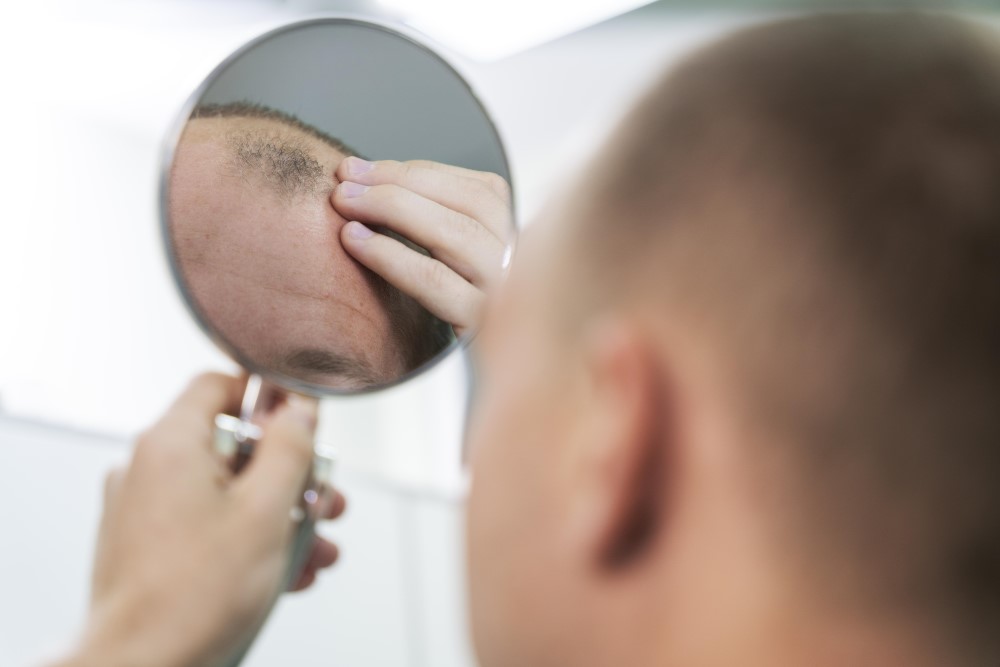
After thoroughly cleaning your scalp, a surgeon uses a small needle to numb an area of your head with local anesthesia. Two main techniques are used to obtain follicles for transplantation: FUT and FUE.
In follicular unit transplantation (FUT):
The surgeon will use a scalpel to cut out a strip of scalp skin from the back of the head. The incision is typically several inches long. This is then closed with stitches. The surgeon next separates the removed portion of scalp into small sections using a magnifying lens and sharp surgical knife. When implanted, these sections will help achieve natural-looking hair growth. In follicular unit extraction (FUE), the hair follicles are cut out directly from the back of the head through hundreds to thousands of tiny punch incisions. The surgeon makes tiny holes with a blade or needle in the area of your scalp that’s receiving the hair transplant. They gently place hairs in these holes. During one treatment session, a surgeon may transplant hundreds or even thousands of hairs. After, the graft, gauze, or bandages will cover your scalp for a few days. A hair transplant session can take 4 hours or more. Your stitches will be removed about 10 days after surgery. You may require up to three or four sessions to achieve the full head of hair you desire. Sessions occur several months apart to allow each transplant to fully heal.
What happens after a hair transplant?
Your scalp may be sore, and you may need to take medications following hair transplant surgery, such as:
- pain medication
- antibiotics to reduce your risk of infection
- anti-inflammatory medications to keep swelling down
- Most people can return to work several days after surgery.
It’s typical for the transplanted hair to fall out 2 to 3 weeks after the procedure. This makes way for new hair growth. Most people will see some new hair growth 8 to 12 months after surgery.
Many doctors prescribe minoxidil (Rogaine) or the hair growth medication finasteride (Propecia) to improve hair regrowth. These medications also help slow or stop future hair loss.
What are the complications associated with a hair transplant?
Side effects from a hair transplant are usually minor and clear up within a few weeks.
They can include:
- Bleeding
- Infection
- swelling of the scalp
- bruising around the eyes
- a crust that forms on the areas of the scalp where hair was removed or implanted
- numbness or lack of sensation on the treated areas of the scalp
- itching
- inflammation or infection of the hair follicles, which is known as folliculitis
- shock loss, or sudden but typically temporary loss of the transplanted hair
- unnatural-looking tufts of hair
What is the long-term outlook?
Typically, people who’ve had a hair transplant will continue to grow hair in the transplanted areas of the scalp.
The new hair may appear more or less dense depending on:
- scalp laxity, or how loose your scalp skin is
- density of follicles in the transplanted zone
- hair caliber or quality
- hair curl
If you don’t take medication (such as minoxidil or finasteride) or undergo a low level of laser therapy, you may continue to experience hair loss in nontreated areas of your scalp.
Discussing the expected outcome with your surgeon and developing realistic expectations is important. Get additional information on hair transplants and their costs here.
Frequently asked questions about hair transplants
Is a hair transplant painful?
The good news is, no — a hair transplant is not painful. At the time of the procedure, the area of your scalp that the surgeon will be focusing on will be numbed with a local anesthetic, so while you may feel a little pressure or movement sensations during the procedure, it shouldn’t be painful.
But like with most postsurgery recovery, you may experience discomfort or pain at the incision points as your body starts to heal and recover. Your medical team will likely discuss the best ways to manage pain and other ways to minimize the risk of negative side effects or reactions.
Is it worth getting a hair transplant?
A hair transplant is a good option for people who can afford the high cost of the procedure and haven’t found success from treatments like minoxidil or Rogaine. Hair transplant surgery is relatively low risk compared with other surgeries, but it isn’t without risks. There is also always the possibility that your hair regrowth may be minimal.
But if this is a procedure you are interested in and the potential rewards outweigh the costs and risks, consider talking with your doctor to see if this is a good option.
Takeaway
If you are experiencing hair loss or hair thinning, there are treatment options available. But no single treatment is guaranteed to work, and the costs can stack up quickly, especially since hair loss treatments are rarely covered by insurance.
But if you’ve talked with your doctor about treatments or found that other common hair regrowth treatments hadn’t worked for you, consider looking into a hair transplant. If you are a good candidate for the transplant and your medical team thinks you’re likely to see positive results, this may be a procedure worth considering.
Looking for professional hair transplantation services? Contact us at Noahair for expert advice and solutions to restore your hair, for more call +918367436003

